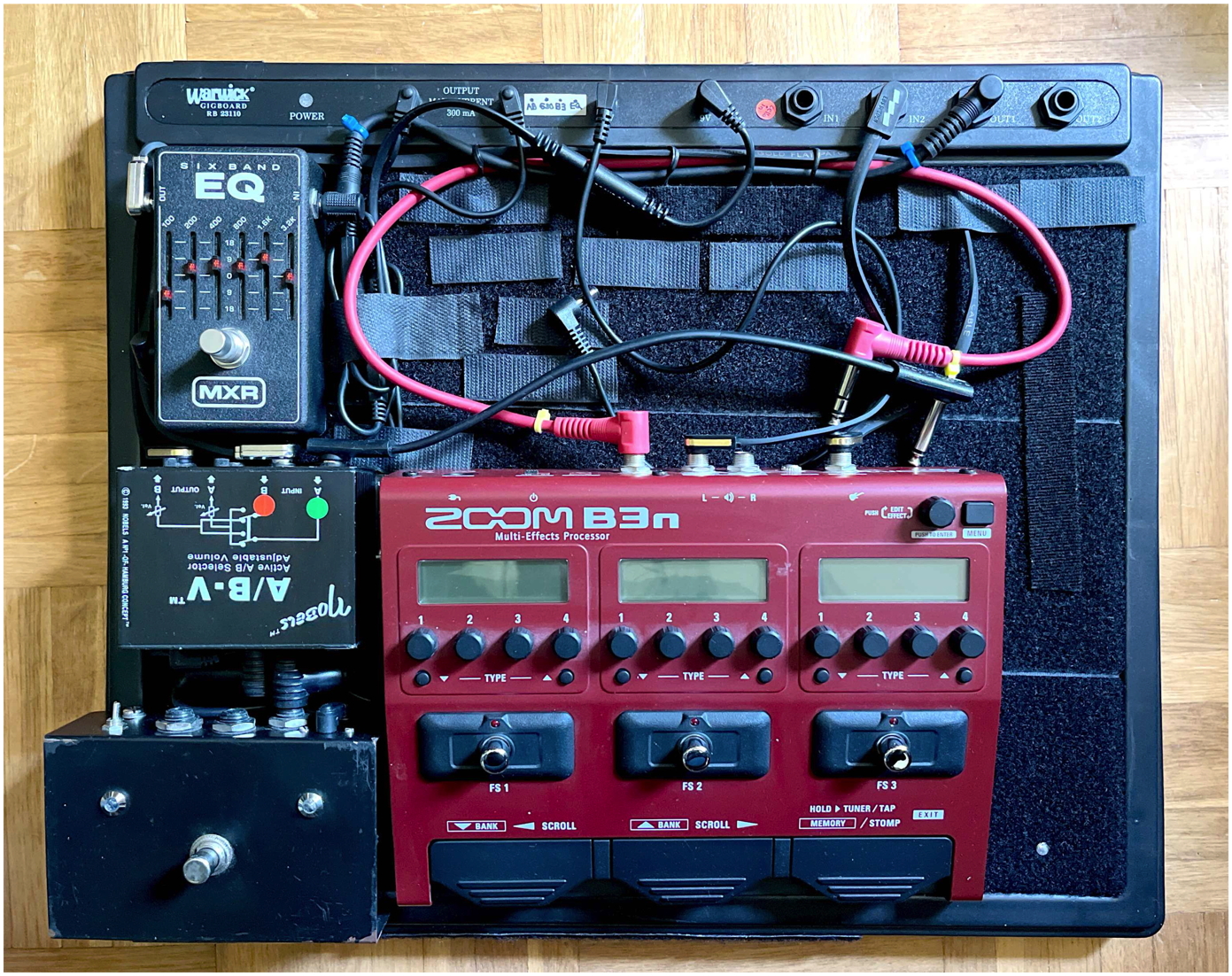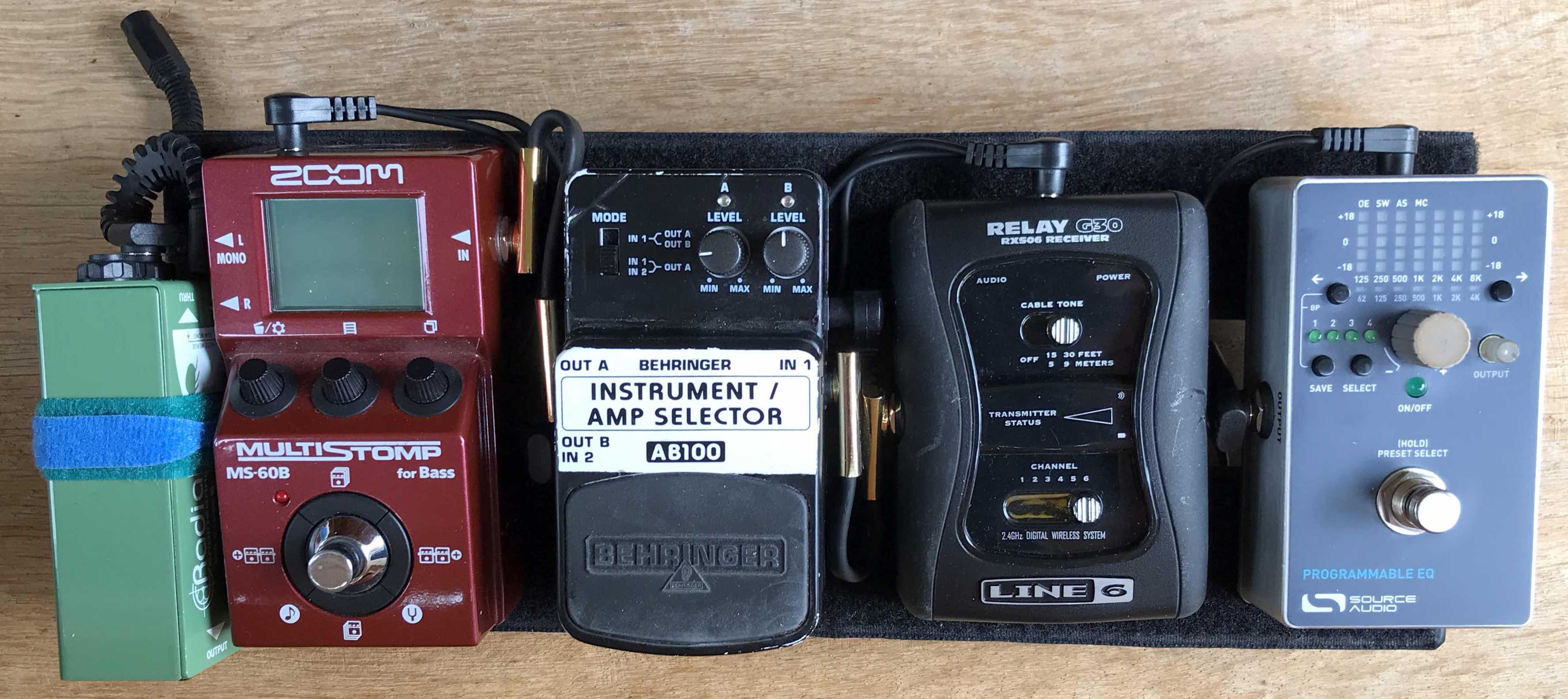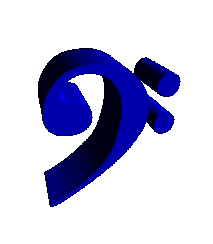My main bass is a customized 4-String Fender Precision Deluxe made in the USA. It has Goto tuners, black hardware, and a neck with electric blue LEDs from SimS (blue pearl LEDs). I bought it in Canada while I lived in Edmonton, Alberta (model description, manufacturer)
My e-cello custom built by Nick Tipney from Black Rock, Novia Scotia, Canada with a Celtic design from my Love Margrit
My standard stage setup is based on the 4-cable method and using the stereo input of the HX Effects to connect my two instruments (bass left, e-cello right), the HX Effects is configured such that I can switch on the fly between the e-cello and the bass. I use a heavily customized pedalboard (Pedaltrain Classic 1):
The bass signal is wirelessly transmitted by the Transmitter Relay G30 and arrives at the Receiver Relay G30 from Line 6.
HX Effects (Line6)
(top,
back).
The left input channel receives the bass signal, the right input channel the e-cello
signal. The HX Effects accomplishes an instantaneous instrument switching in the middle
of a song. I use for this 2 Helix blocks, either pans or 2 sends sending nothing on A
and B path after splitter. To adjust the signal levels between bass and e-cello I need
one additional block, i.e. 10-band EQ. This instrument switch is controlled by a single
footswitch (FS4) custom labelled with e-cello and using a red ring.
Expression pedal FP02 (Zoom) connected to the HX Effects
MS-60B MultiStomp for Bass (Zoom)
adding amp and cab simulations, which the HX Effects is missing.
Footswitch controller BFC-6
to control the bass amp (Trace Elliot)
DC-Brick multi power supply (Dunlop)

My alternative stage setup (shown here currently without the Receiver Relay G30 and expression pedal) has similar functionality as my standard stage setup, but it's more portable and assumes I have not my big Trace Elliot amp with me (no footswitch controller on the board). The effects board is a Rockbag RB 23110 (dimensions 40.5 x 30 x 10 cm) from Warwick. On our tours I took it as hand luggage onto planes (adding a few cloths to the bag), having checked in the rest, i.e. my bass and e-cello (both in hard cases) plus the tripod for the e-cello:
The bass signal is wirelessly transmitted by the Transmitter Relay G30 and arrives at the Receiver Relay G30 from Line 6.
The e-cello signal is a cable connection coming from the e-cellos lower output jack. It enters the effects board input port IN1 (red dot). With this arrangement it is convenient to plug the e-cello to the board and allows to have throughout fixed cable connections on the board. No dangling cables.
The e-cello signal goes from the OUT1 port on the effects board to the 6-Band Equalizer (M109 MXR) from Dunlop.
The two instrument signals go to a Y-switch arrangement.
I play either bass or e-cello. No sound should come from the bass if it dangles in
front of me
while playing the e-cello and vice-versa. I need to be able to switch between my
two instruments in the middle of a song back and forth fast. LED's tell me
which instrument is currently connected to the sound system. My habit:
•
The red LED is for e-cello playing
•
the green LED for bass playing
This Y-switch is accomplished in the following manner: The actual audio
signal is switched by a versatile, high quality
AB-V Selector Box
from
Nobels.
Input A receives the bass signal, Input B the e-cello signal.
Output B serves as the main output
(manual).
The device allows also volume adjustments.
However, that switch box, the versatile it is, is
NOT a stomp box. Therefore, I needed some additional device with a foot switch
to trigger the instrument switch with my feet. I found no product on the
market, which would have done the job. I needed a stomp box that can trigger
the Nobels AB-V box and which shows me clearly the status by two easily visible
LED's, well visible even on a dark stage.
Thus I built myself a latching
stomp switch
MusEQ FS-LAF
(5).
That switch shows nicely the status
(• - b / • - cello)
under all light conditions. This custom built foot switch allows me to
switch instruments even in the middle of a song absolutely noiselessly without
any clicks nor other audible noises!
To have minimum weight on tour, notably when I have to bring along the effects board with my check-in luggage, I favor the Zoom B3n or B3 variant over the POD X3 variant.
Remark on the Relay G70 receiver from Line 6: I found it first quite attractive for saving space on the board by using it as a receiver as well as an A/B switch by scene switching (former setup using G70). For that purpose the e-cello is connected via cable and uses the Aux In input on the Relay G70 (wiring). The bass connects wirelessly. Unfortunately with the Relay G70 there is an unacceptably long delay when switching from the e-cello back to the bass. This is due to the fact that the wireless connection with the bass is not being upheld when the scene is switched to the e-cello input. The G70 requires a few seconds to establish that wireless connection. Thus the Relay G70 is not fast enough for switching instruments in the middle of a song as I did a lot with my band NSAHB. As instrument switching comes already with a lot of challenges, stomp foot switch, getting the bow out of or back into the quiver, check LEDs for all being set correctly, and playing..., then dealing with the seconds long delay from the G70 was simply too much. I gave up on the G70, as nice a device it is. Line 6 should have designed it better, i.e. upkeeping the wireless connection while switching the output signal thereafter. I had a ticket going but Line 6 stopped manufacturing the G70 anyway (Line 6 wireless).
I power the board with a 1SPOT as the original power supply that came with the board provided insufficient power. After about a half hour using the board, it suddenly went black. For this to work I needed to customize the board (pictures of modification). I bypassed the circuit that reduced the 12 V voltage to the needed 9V and regularly shut the board down. Instead I mounted a standard 9V jack (tip +, barrel -) to power the 4 power connectors of the board. However, as they are not isolated and I am anyway needing power for more than 4 devices I use also the original Zoom power supply to power the B3n or B3. Note, powering all 5 devices with a single 1SPOT would result in a bad noisy signal. In my experience the B3n is particular sensitive and needs well isolated power lines if those are coming from the same power supply.

A carry-on minimal stage setup is based on the pedalboard Nano from Pedaltrain. It is so small, it can be carried easily attached to a gig bag (total weight including bag and everything: 2.4 kg). Yet, it offers full functionality including the switching between e-cello and bass (wiring of the audio signals):
Relay G30 receiver receiving the bass signal from the Relay G30 Transmitter from Line 6.
Source Audio Programmable EQ. It does the tonal and volume adjustment between the e-cello and the bass.
Behringer A/B Switch. It does the actual instrument switching. "In 1" receives the bass signal from the G30 (green LED •), "In 2" receives the e-cello signal from the EQ (red LED •). It is the weakest device on the board as it is not as noiseless as I would like to have it. It is of course run in the "In 1/In 2 -> Out A" mode.
Zoom MS–60B. It receives the signal from the output of the Behringer A/B Switch. It offers also a tuner and can be bypassed.
Passive DI-Box (StageBug SB-2) from Radial. This offers an unbalanced THRU or balanced XLR actual DI output (wiring).
1SPOT, which powers the entire board reliably. No conspicuous noise issues.
and then of course...
